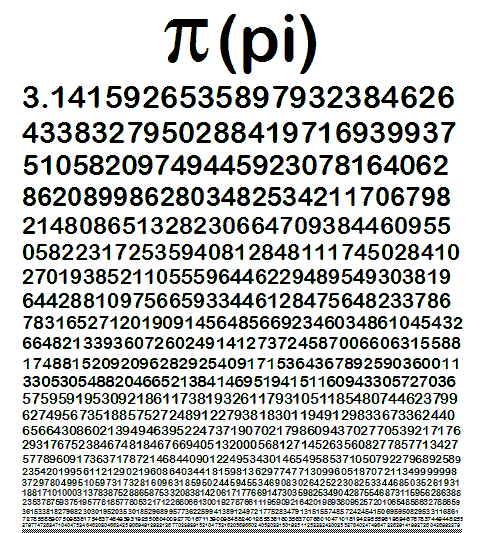
Pi is known the world over, an A-lister of the number world. It is perhaps most famous for the fact that the number, which is the ratio of a circle’s circumference to its diameter, never seems to end. Efforts to round it properly have been in vain, with 3.14… proving to have many millions of decimal places.

Pi (also known as π in symbol form) is celebrated (sort of) every year on March 14, International Pi Day (3.14, get it?). But it could have been oh so different had the state of Indiana gotten its way. For in 1897, the Indiana House of Representatives comfortably passed (67 votes for and none against) a law which became known as the “Indiana Pi Bill”. Had it passed a second reading in the state Senate, 3.141592…. (and so on) would have been no more, in Indiana at least. Instead, pi would have been redefined as a nice, round number- 3.2. It certainly would have made school easier, but it was ,of course, gobbledegook.
So why was the state of Indiana attempting to contradict thousands of years of mathematical effort? It all starts with an age old problem in Maths, “squaring the circle”. For centuries, mathematicians had been trying to find a square which had the same area as a given circle, using only a ruler and compass. In 1882, it was confirmed by a Ferdinand von Lindemann that, as long as π (that never ending number) was involved, the problem could not be solved (if you’re looking for the nitty gritty maths of this, see the end of the article!).
A certain Indiana mathematician, Edward J. Goodwin, disagreed. In 1894, Mr Goodwin published an article in the American Mathematical Monthly called “Quadrature of the Circle”. He claimed to have indeed found a square that fits into a circle, both shapes having the same area. Sadly, this mathematical miracle was seriously flawed. His errors are best summed up by the phrase
“We are now able to get the true and finite dimensions of a circle by the exact ratio 5/4: 4”
In other words, Goodwin was replacing pi, relied on for centuries, with a new ratio. The new number, rather than having millions of decimals, had just one. His new “pi” was 3.2. This ludicrous theory could be unproven by simply drawing a circle and taking some measurements (the circumference would not be 3.2 times the diameter). However, his findings were nonetheless published (although, perhaps tellingly, the article contains an editor’s note- published on request of the author).
By 1897, Goodwin was ready to make serious money on his new discovery. Having already gained copyright for his new theory in the US and 7 other countries, he planned to sell his new theory for school and university textbooks around the world. He was, however, loyal to his home state. Keen that they should be able to benefit for free, he convinced a state representative, one Taylor I. Record, an Indiana farmer, to introduce an astonishing bill to the House of Representatives.
The bill called for, above all else, the establishment of a “new mathematical truth”. Under the terms of the bill, Indiana would gain free access to his “theory” is they accepted his findings. That is, if they accepted that pi, 3.14…, was in fact 3.2. The bill stated
“the ratio of the diameter and the circumference is as five fourths to four”
This ratio, known for so long as 3.14…, was a completely different number. Goodwin’s statement was nonsense. Amazingly, rather than being laughed out of the chamber, the House passed the bill with not a single vote against. Mr Record, who had introduced the bill, later admitted he had very little idea what any of it meant. It is likely that his colleagues didn’t either and simply saw an opportunity to gain a trademark for free.
So pi was now one Senate vote away from being altered forever (In Indiana at least). Thankfully for mathematical sanity, a Professor C.A. Waldo of Purdue University, Indiana, had caught wind of developments. Astonished that the bill had gotten so far, he contacted several senators to explain to them that, quite apart from the fact that Goodwin was wrong, Indiana was very likely to make no money whatsoever from it as a result. The Senate, alarmed, quietly dropped the bill before a 2nd vote, although technically the voting record still stands- at no point did an Indiana state representative vote against turning 3.14 into 3.2.
The remarkable incident marks one of the few times in history that a government has attempted to alter, or even define, “mathematical truth”. Unwittingly or not, Indiana attempted to change a number which had been accepted for thousands of years, and by proxy attempted to help Goodwin “solve” the age old circle squaring problem which was already accepted as impossible. Indiana and Goodwin had, almost literally, tried to fit a square peg into a round hole. Had they gotten their way, pi Day may even be on the 2nd of March (or 20th, had 3.20 caught on)! They also would have ensured that generation after generation of (Indiana) school child would have struggled badly when calculating the area of a circle.
Happy Pi Day!
The Maths in more detail
Squaring the Circle
Until the end of the 19th century, a mathematical mystery was the following:
How can you construct a square which has the exact same area as a given circle, using only traditional mathematical drawing methods (in simple terms- a ruler and compass).
Lets look at the problem mathematicians of the time faced.
The area of a square is its length multiplied by its breadth. This is known as
A = l x b
Of course, a square’s sides are equal, so both the length and the breadth, naturally, are the same.
The area of a circle is the radius (half its diameter) multiplied by itself, and then multiplied by, you guessed it, pi. This formula is known as
A = πr²
In attempting to “square the circle”, mathematicians once thought that the problem of finding 2 identical areas could be solved by the shapes below.

A square with sides which multiplied together to give pi, as well as a circle with radius 1, would do the trick. In maths, a number which multiplies by itself to give a new number is known as the “square root” of the new number. So, mathematicians were looking for the square root of pi. This would give the area of the square as
A = root π x root π = π
As for the circle with radius 1, this would give us
A = πr² = π x 1 x 1 = π
Problem solved! Sadly, not. Turns out, pi is such a special number that its square root simply cannot be found. It is known as a “transcendental” number. So our square, which has sides root pi, cannot exist. In 1882, a mathematician called Ferdinand von Lindemann confirmed the impossibility of this and, therefore, it was confirmed that “squaring the circle” was beyond our capabilities. Of course, Mr Goodwin and the Indiana House disagreed!.
